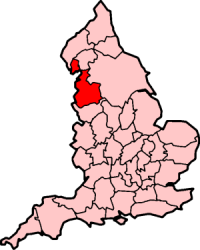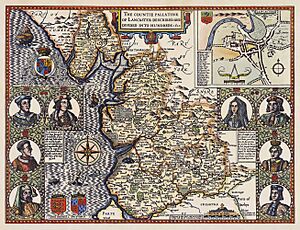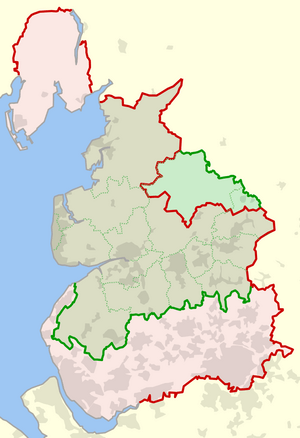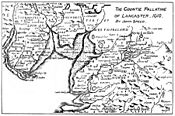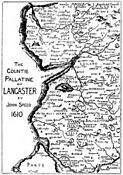History of Lancashire facts for kids
Lancashire is a county in the northwest of England. It's one of the younger traditional counties, first created around 1182. Before that, it wasn't even mentioned in the Domesday Book of 1086, which was a big survey of England.
Historically, Lancashire had two main parts. The larger part stretched along England's northwestern coast. When it included cities like Manchester and Liverpool, it was about 76 miles long and 45 miles wide. A smaller, separate part, called Furness and Cartmell, was north of Morecambe Bay. The tallest point in the historic county is the Old Man of Coniston, which is 2,633 feet (803 meters) high.
Lancashire was once a "county palatine." This meant the Duke of Lancaster had special powers, almost like a king, over justice and government within the county. However, in 1399, one Duke, Henry Bolingbroke, became King Henry IV of England. Since then, the Duchy of Lancaster and its special powers have belonged to the King or Queen. This means the area is run like the rest of the country, but with some old traditions still in place.
Big changes happened in 1974. The old administrative county was split up. Areas around Manchester became part of Greater Manchester, and areas near Liverpool became part of Merseyside. The northern part, including Furness, joined Westmorland and Cumberland to form Cumbria. However, the new Lancashire gained control of areas like the Forest of Bowland from Yorkshire.
Even with these changes, historic Lancashire is still recognized as a cultural and geographical area. Its traditional borders are still followed by groups like the Lancashire FA. The High Sheriffs for Lancashire, Greater Manchester, and Merseyside are still chosen by the King or Queen through the Duchy of Lancaster. The Duchy also gets unclaimed property in the area, and the money goes to charities.
The symbol of historic Lancashire is the Red Rose of Lancaster, which comes from the English royal House of Lancaster. In 2008, the Flag of Lancashire was officially recognized. Every year on November 27th, people celebrate Lancashire Day. It's a day to enjoy the county's history and its unique dialect.
Contents
What's in a Name?

The name Lancashire comes from the city of Lancaster. The name Lancaster means 'Roman fort on the River Lune'. It combines the river's name with the Old English word cæster, which came from the Roman word for a fort or camp.
In old documents, the county was sometimes called the "County of Lancaster." The name "Lancastershire" was used in the late 1300s. But over time, "Lancashire" became the common name.
Early Days
When the Romans arrived in England, the area that would become Lancashire was home to tribes like the Brigantes. Roman forts were built in places like Manchester, Lancaster, and Ribchester. Roman roads also connected these forts.
Later, this land was part of the Kingdom of Northumbria. The River Mersey was often seen as the border with another kingdom, Mercia. After the Norman conquest in 1066, William the Conqueror gave some of these lands to a lord named Roger de Poitou. However, by the time of the Domesday survey, much of it was back under the King's control.
In the Domesday Book, some parts of what would become Lancashire were listed under Yorkshire or Cheshire. The area between the Rivers Mersey and Ribble was called "Inter Ripam et Mersam." It was divided into six "hundreds," which were old land divisions: Blackburn, West Derby, Leyland, Newton, Salford, and Warrington.
The town of Lancaster itself was linked with areas like Kendal and Furness. These areas were often managed by local leaders.
A County is Born
After 1086, Roger de Poitou got his lands back. Areas like Lonsdale, Cartmel, and Furness were added to his control. This helped defend the area south of Morecambe Bay from Scottish raiders.
Lancashire faced many attacks over the centuries. Scottish raids happened from 1138 to 1322, reaching as far south as Chorley. Later, during the Jacobite rebellions, a battle took place in Preston in 1715. In 1745, Bonnie Prince Charlie marched his army through Lancashire, gaining supporters in Manchester.
The first mention of a separate "County of Lancaster" appeared in records in 1168. By 1182, Lancaster was officially recognized as its own shire.
In 1267, Edmund Crouchback, son of King Henry III, became the first Earl of Lancaster. His grandson, Henry of Grosmont, became the first Duke of Lancaster in 1351. He was given special "palatine" powers, meaning he controlled justice and government in the county. He appointed his own judges and officers.
These special powers were meant to last only for Henry's lifetime. But when his daughter married John of Gaunt, son of Edward III, the dukedom and its powers were given to him. John of Gaunt made sure his male heirs could inherit these powers. When his son, Henry of Bolingbroke, became King Henry IV in 1399, he kept the Duchy of Lancaster separate from the Crown's other lands. This meant Lancashire's special legal system continued, even though it was now part of the kingdom.
Once its borders were set, Lancashire was divided into six "hundreds": Amounderness, Blackburn, Leyland, Lonsdale, Salford, and West Derby. These hundreds were further divided into smaller areas called townships.
In 1461, Edward IV decided that the county palatine should become part of the Duchy of Lancaster. From 1471, the same person held the top jobs for both the Duchy and the Palatinate. The main office moved to London, but Lancaster remained the legal center.
Industrial Revolution
| Districts and County Boroughs of Lancashire in 1961 | |
|---|---|
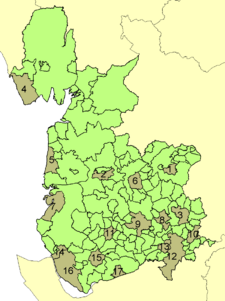 |
|
Lancashire was a key place for the start of the Industrial Revolution. This was a time when new machines changed how things were made. Lancashire had a long history of making wool. But when cotton imports increased, it led to new inventions. Famous inventors like John Kay, Richard Arkwright, Samuel Crompton, and James Hargreaves, who created machines for weaving and spinning, were from Lancashire.
Around 1700, one of the first blast furnaces in Lancashire was built in the Cliviger gorge. This helped with metal production.
As the Industrial Revolution continued, many towns in Lancashire grew very quickly. By 1862, 22 towns became official boroughs, which gave them more local control.
Over time, many of Lancashire's special legal systems were merged into the national courts. By 1875, only the Court of Chancery and the Chancellor's power to appoint local officers remained.
County Hall in Preston was built as the main office for the county government. It opened in 1882. The Blackpool Tramway, one of the oldest electric tramways in the world, opened in 1885.
In 1889, the "administrative county" of Lancashire was created. This covered the historic county but left out big cities like Blackburn, Burnley, Liverpool, and Manchester. These cities became "county boroughs," which meant they governed themselves.
During the 20th century, the county became even more urban. More cities like Blackpool and Southport became county boroughs. The borders around Manchester became very complex, with parts of the administrative county squeezed between the self-governing county boroughs.
Modern Lancashire
By 1971, Lancashire and its county boroughs had over 5 million people, making it the most populated county in the UK. In 1972, the last major part of Lancashire's special legal system, the Court of Chancery, also joined the national High Court.
On April 1, 1974, big changes happened again due to the Local Government Act 1972. The old administrative county and all the county boroughs were abolished. The busy southern parts became new "metropolitan counties": Merseyside and Greater Manchester.
For example, Liverpool and its surrounding areas became part of Merseyside. Manchester, Bolton, and Salford became part of Greater Manchester. Some areas like Warrington joined Cheshire. However, the new Lancashire gained some areas from Yorkshire, like Barnoldswick and the Forest of Bowland.
In 1998, Blackpool and Blackburn with Darwen became "unitary authorities." This means they manage their own local services, but they are still part of Lancashire for ceremonial purposes, like policing and fire services.
In 2005, the power to appoint magistrates (local judges) in Lancashire, Greater Manchester, and Merseyside was given to the national Ministry of Justice.
Images for kids
- Maps of early Lancashire
See also
- Duchy of Lancaster
- History of England
- History of Liverpool
- History of Manchester
- House of Lancaster



